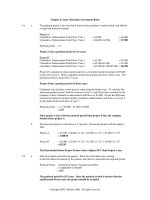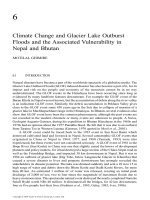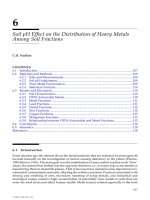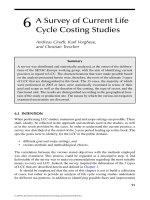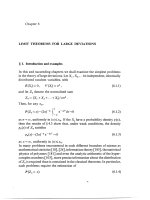STREAM ECOLOGY & SELF PURIFICATION: An Introduction - Chapter 6 ppt
Bạn đang xem bản rút gọn của tài liệu. Xem và tải ngay bản đầy đủ của tài liệu tại đây (348.51 KB, 8 trang )
Stream Water
Our planet is shrouded in water, and yet
8
million children under the age of
five will die this year from lack of safe water. The same irony will see
800
mil-
lion people at risk from drought.
.
.
.
Two-thirds of the world's rural poor have
no access to safe drinking water, and while millions are
made
homeless
from floods, hundreds of millions are coping with
6.1
WHERE
IS EARTH'S
WATER LOCATED?
W
ATER
continually moves around and above the earth as water vapor, liquid
water, and ice. Moreover, water is continually changing its
form. The
earth is almost
a
"closed system," like a terrarium. That means that the earth, as a
whole, neither gains nor loses much matter, including water. The water cycle
(see Section 6.3) continually recycles water all around the globe, which means
that the water we drink today was once used by our predecessors, in near time
and very ancient
time.87
Water
covers three-quarters of the earth's surface. Most of this water is salt-
water (about 97% of the earth's water) in the oceans, and less than 3% is fresh-
water. Of the latter, 77% is frozen in polar ice caps and glaciers,
22%
is ground-
water,
and the remaining small fraction is in lakes, rivers, streams, plants, and
animals.
From Figure 6.1, it is apparent that we generally only make use of a tiny por-
tion of the available water supplies.
The
right-side pie shows that the vast ma-
jority of the freshwater available for our uses is stored in the ground.
Look at the data provided in Table 6.1. Surface-water sources (such as
streams and rivers) only constitute about 300 cubic miles (about
1/10,00Oth of
one
percent) of the world's total water supply of about 326 million cubic miles
of water; yet streams and rivers are the source of most of the water used.
86~hat Water Shortage?
New York: United Nations Environment Program (UNEP),
pp.
1-5,
undated.
87~here
is
Earth's Water Located?
USGS
Water Resources:
pp.
1-2,
February
2000.
Copyright © 2001 by Technomic Publishing Company, Inc.
STREAM WATER
Figure
6.1
Earth's water available for our uses, and the forms
in
which it exists. (Source: USGS
Wa-
ter Resources, , p. 2,2000.)
Through history, the world's surface waters, i.e., lakes, streams, and rivers,
have provided important resources and services (water available for human
use), including water for drinking, washing, agriculture, energy production,
transportation, recreation, and waste disposal.
Humans cannot live without water. Consider the
5-5-5 Rule-humans can
live about five minutes
without air, about five days without water, and about
five weeks without food. And, water has several uses. All essential "biochemi-
cal processes occur in
water."88 Moreover,
water has limitations. It is very un-
evenly distributed around the world. Much of the Middle East, most of Africa,
parts of Central America, and the western United States are already short of wa-
ter.89 Unfortunately,
water has been treated as an unlimited resource. This atti-
TABLE
6.1.
Earth's Water Supply.
Water Volume, Percent of
Water Source
in
Cubic Miles Total Water
Oceans
Ice caps, glaciers
Groundwater
Freshwater
lakes
Inland seas
Soil moisture
Atmosphere
Rivers (streams)
Total water volume
Source: Where is Earth's Water Located?
USGS
Water Resources:
http:llwww.ga.usgs.gov/edu/
earthwherewater.htm1, p.
2,
February
2000.
88~radbury, I., The Biosphere. New York: Belhaven Press, p.
16,
1991.
89~orld ~esources
1986.
New York: World Resources Institute (WRI) and International Institute of Environment
and Development
(IIED), pp.
113-1
16,
1986.
Copyright © 2001 by Technomic Publishing Company, Inc.
Water: Earth's
Blood
TABLE
6.2.
U.S.
Water Withdrawals
per
Day,
1940-1
985.
I
Year
Billion Gallons
Source:
U.S.
Bureau of Census (phone query,
1996).
tude, if continued, could lead to critical shortages in quantity and critical defi-
ciencies in quality of available water.
Another water limitation concerns usage; that is, the trend toward
overusage. For example, from Table
6.2,
it can be seen that between 1950 and
1980, the amount of water drawn from lakes, rivers, streams, reservoirs, and
underground aquifers in the United States increased by
150%, while the popu-
lation increased by only
half.90
Another water limitation
is water quality. Data compiled by
WRI
and
IIED
indicate that the world's lakes and rivers receive enormous quantities of munic-
ipal sewage, industrial discharges, and surface runoff from agricultural areas
on a continuous basis.
If
the discharge of pollutants into our groundwater and
surface waters is not stopped, the survival of future generations is at
risk.g1
To
this point in this discussion, we have covered the fundamentals of ecol-
ogy in limited and very basic form. The intent has been to lay a foundation upon
which the focus of this text, stream ecology and self-purification, can be built.
Beginning with an introduction to water and its importance, the rest of this dis-
cussion focuses on the main topic area.
6.2
WATER: EARTH'S
BLOOD
Water is the life blood of the universe. Living organisms, themselves about
70% water, depend upon water as a medium and reactant for biochemical reac-
tions, for circulation, and for support. Water covers about 75% of the earth's
surface. Life on the earth probably originated in water. More than half of the
world's animals and plant species live in water. Most of our food is water: to-
matoes
(95%), spinach (91%), milk (go%), apples
(85%),
potatoes (go%), beef
(61%), and
hot dogs (56%). Water is at once simple and complex. It is so com-
plex that we can't define, beyond its chemical formula, what water really
ismg2
goweber,
S.
(Ed.),
USA
by
Numbers.
Washington,
DC:
Zero
Population
Growth,
p.
17,
1988.
9'~RI
and
IIED.
World Resources 1988-1989.
New
York:
World
Resources
Institute
(WRI)
and
International
In-
stitute
of
Environment
and
Development
(IIED),
p.
133,
1988.
92~pellman,
F.
R.,
The Science of Water: Concepts and Applications.
Lancaster,
PA:
Technomic
Publishing
Com-
pany,
Inc.,
p.
13,
1998.
Copyright © 2001 by Technomic Publishing Company, Inc.
68
STREAM
WATER
Whether we can define it or not, however, humans know water not so much
for what it is, but instead for its
use(s). Water is used to
maintain health and for
industrial and home use, sanitation, agriculture, power production, recreation,
and much else.
Water is a stable molecule composed of one atom of oxygen and two atoms
of hydrogen. Water is unique in that it is the only material found on earth in the
three basic states at standard temperatures. These states are liquid (water), solid
(ice), and gas (water vapor). At sea level water vaporizes at
100°C (212°F) and
freezes at
0°C (32°F).
At
4°C
(39.2"F), water is most dense. In a body of water,
as water approaches this temperature during the spring and fall, a mixing action
takes place whereby the denser water displaces water at lower levels. This mix-
ing action aerates the water and brings nutrients to the surface.
6.3
WATER, OR HYDROLOGIC, CYCLE
The water, or hydrologic, cycle is shown in Figure 6.2. As illustrated, the
water cycle depicts the ongoing natural circulation of water through the bio-
sphere. Water is taken from the earth's surface to the atmosphere by evapora-
tion from the surface of lakes, rivers, streams, and oceans. This evaporation
process occurs when water is heated by the sun. The sun's heat energizes sur-
face molecules, allowing them to break free of the attractive force binding them
together, and then evaporate and rise as invisible vapor in the atmosphere. Wa-
ter vapor is also emitted from plant leaves by a process called
transpiration.
Ev-
ery day, an actively growing plant transpires five to ten times as much water as
it can hold at once. As water vapor rises, it cools and eventually condenses, usu-
ally on tiny particles of dust in the air. When it condenses, it becomes a liquid
again or turns directly into a solid (ice, hail, or snow). These water particles then
collect and form clouds. The atmospheric water formed in clouds eventually
falls to earth as precipitation. Most precipitation falls in coastal areas or in high
elevations. Some of the water that falls in high elevations becomes runoff wa-
ter, the water that runs over the ground (sometimes collecting nutrients from the
soil) to lower elevations to form streams, lakes, and fertile valleys.
The water that we see is known as
suqace water.
Surface water can be bro-
ken down into five categories: oceans, lakes, rivers and streams, estuaries, and
wetlands.
6.4
STREAM WATER
As Allen points out, we all have an intuitive appreciation that flowing wa-
ters, such as streams, contain a variety of dissolved and suspended constituents
(see Figure
6.3).93
Further, a stream is a carrier of those constituents it is ex-
posed to as it makes its inexorable journey over land to the sea.
93~llen,
J.
D.,
Stream Ecolog~: Structureand Function ofRunning Waters.
London:
Chapman &Hall,
p.
23,1996.
Copyright © 2001 by Technomic Publishing Company, Inc.
Figure
6.2
Water cycle. (Source: Modified from Carolina Biological Supply Co.,
1966,
with per-
mission.)
Figure
6.3
Stream water constituents.
Copyright © 2001 by Technomic Publishing Company, Inc.
70
STREAM
WATER
Many factors influence the composition of stream water, causing variations
from place to place. Precipitation is, of course, one major source of chemical in-
puts to streams. Most streams contain much more suspended and dissolved ma-
terials than found in rainwater, snow, or hail, however. Ultimately, all of the
constituents of stream water originate from dissolution of the earth's rocks. The
dissolving of rocks is commonly the major
determinant of stream water chem-
istry
locally as well. These "determinants" of stream water chemistry are actu-
ally the stream's "DNA." More specifically, if we were to analyze a sample of
stream water, at any given time or place, the dissolved and suspended constitu-
ents found in the stream water sample would literally provide us with a sort of
"DNA"
footprint, or signature, of where the stream has been. It is this "DNA"
footprint that allows us to
determine and
often pinpoint, in many cases, the ori-
gin of point- and non-point source pollution.
In our pursuit of presenting a logical discussion of stream ecology and
self-purification, we share the view of Dr. David
M.
Rosenberg: "Chemical
measurements are like taking snapshots of the ecosystem, whereas biological
measurements are like making a videotape.
. .
.
"94
Thus, in this discussion of
stream ecology and self-purification, it is the videotape (the biological) that we
focus on.
6.5
KEY
TERM
Hydrologic Cycle (Water Cycle)-involves the circulation of water be-
tween the earth's surface and its atmosphere.
6.6
CHAPTER REVIEW
QUESTIONS
6.1
Surface-water sources constitute about
cubic miles of the
world's water supply.
6.2
Less than
%
of the earth's water supply is freshwater.
6.3
The earth is almost a closed system. Explain.
94~osenberg,
D.
M.,
"A National Aquatic ecosystem health program for Canada: We should go against the flow."
Bull. Entomolo. Soc.
Can.,
Winnipeg Freshwater Institute, 30(4):144-152, 1998.
Copyright © 2001 by Technomic Publishing Company, Inc.
Chapter
Review
Questions
6.4
Explain the
5-5-5
rule.
6.5
Humans know water not so much for what it is, but instead for its
6.6
Explain the hydrologic cycle.
Copyright © 2001 by Technomic Publishing Company, Inc.
This page intentionally left blank
Copyright © 2001 by Technomic Publishing Company, Inc.
